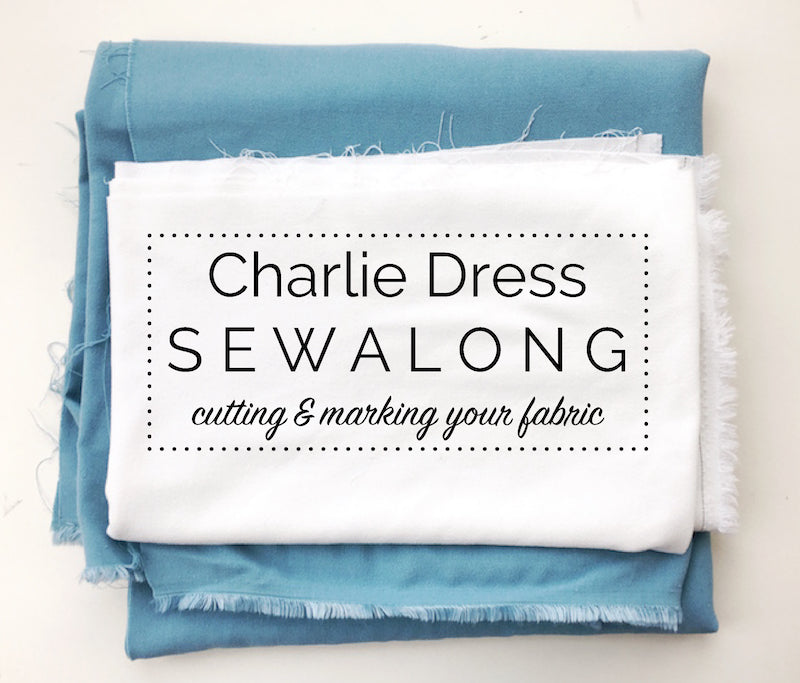
Time to get your shears out, Sewalongers - things are starting to hot up today as we finally get to cut into our precious fabric!
Today we will be:
- Making sure we've pre-washed our fabric
- Talking about grainlines and selvedges
- Cutting out our fabric
- Transferring all notches and markings
*Please click here to be taken to all the posts in the Charlie Dress Sewalong*
Preparing to cut...
Before we begin, have you pre-washed your fabric?? Provided you're working with fabric that actually can go in the washing machine (and you intend to wash it that way after it's all sewn up), pre-washing ensures that any minor shrinkage of the fibres will be done and dusted before you cut and sew; resulting in a garment that will not shrink on it's first wash.
Second of all, if you haven't yet assembled your pattern and cut out your size, do that now! If you're having trouble printing your PDF pattern at home, or not sure what to ask of your local copyshop or printer's, please read this post first.
How to lay out your fabric
If this is your first time working from a sewing pattern, you may be wondering how best to fold your fabric, what in the hell a "selvedge" really is, and exactly how to locate that elusive grainline... No fear, we've all been there!
Firstly, "selvedges" are the woven edges at either end of the fabric that come infinitely off the roll. We always find things much easier to explain with a little drawing...

When you fold your fabric ready to lay on your pattern pieces, you'll need to fold it in half lengthways, so that the fold is parallel to the selvedges, and from there the rest is easy: the "grainline" is also parallel to the selvedge, and the "bias" is basically just an imaginary line that runs diagonally across the fabric, at a 45° angle to the grainline. If a garment is "cut on the bias", it will have significantly more drape, body and stretch than something cut on the straight grain, but will also be slightly tricker to work with.
Once you've located the selvedges and folded your fabric (right sides of the fabric together - a good habit to get into as it protects the right side of your fabric and makes transferring pattern markings easier and clearer later on), you're ready to start pinning on your paper pattern pieces ready to be cut, using the layplans in the instructions as a guide.

We've gone for a navy and floral Michael Miller border print quilting cotton for the tiered skirted Variation 1. Seeing as quilting cotton is very stable and not slippery or shifty like rayon, a lot of silks and other drapey polyesters, the cutting process is simple and straightforward - we've pinned the pattern pieces into place and cut them out carefully using a sharp pair of fabric scissors.
For Variation 2 we've chosen a slightly heavier wool crêpe blend which will drape and fall beautifully on the 3/4 circle skirt, is nice and easy to work with and has a tiny bit of stretch so the bodice will hug like a glove!
If you're working with a lightweight drapey fabric however, you'll need to take more care and precaution at this stage (and all stages, really!) in order to end up with pattern pieces that are accurately cut and your sanity still intact...! We've compiled a monster list of tips and tricks for working with drapey and slippery fabrics - well worth a read now before you get cutting!
When preparing to cut, pay extra attention to:
- Pieces that need to be placed on the fold of the fabric
- Placement of the pattern pieces according to the grainline & bias
- Pinning the pattern pieces to the fabric - keep pins as flat as possible to avoid distorting the fabric as you pin
- Saving space! Place the pattern pieces as close as possible to each other in order to waste as little fabric as possible
- Cutting - if you're using fabric scissors and you're right handed, always cut to the left of your pattern piece (and if you're left handed you'll need to cut to the right) - this lifts and distorts the fabric less and enables a cleaner, more precise cut, especially around curves! If you're using a rotary cutter - righties cut to the right, and lefties to the left!
Transferring pattern markings
As you're pinning and cutting, you'll notice that the pattern pieces have a whole lot of information on them - the name of the pattern, what piece it is, ie. a bodice centre front or a skirt piece, how many pieces to cut, and so on. You'll also notice a bunch of strategically placed little black triangles - notches - around the edges. These notches come into play when you're sewing up your garment, as they indicate key points where two pattern pieces should match up as you're pinning them together ready to sew.
To transfer these notches, simply snip through the middle of the triangle, through your pattern paper and all layers of fabric:
You don't want to snip any further than 3/8" or 10mm in from the raw edge, and if your fabric is especially prone to fraying, like our wool crêpe is, instead of snipping into the seam allowance, cut little triangles poking out as you're cutting around your pattern pieces.
Once you've got all your pattern pieces cut and ready to go, avoid the temptation to remove the pins and file away the pattern paper - some pieces are pretty alike and easily mixed up if not clearly labeled. We like to keep our pattern paper pinned into place until the piece in question is needed for sewing...!
Up next: Time to start sewing! We'll be making some serious headway and getting our bodices all sewn up.







Comments on this post (0)